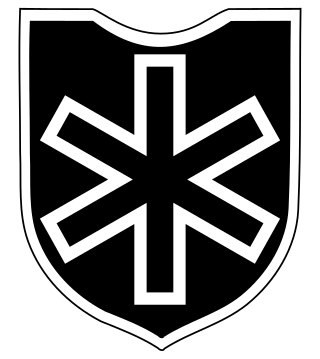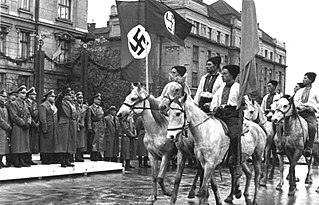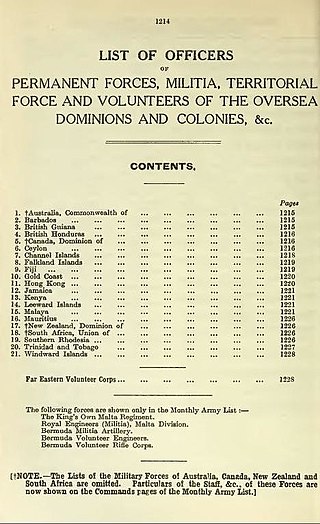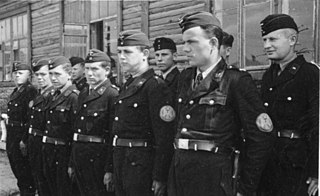
The 4th Indian Infantry Division, also known as the Red Eagle Division, is an infantry division of the Indian Army. This division of the British Indian Army was formed in Egypt in 1939 during the Second World War. During the Second World War, it took part in campaigns in East Africa, Syria, North Africa and Italy. Post independence, the division is part of the I Corps and headquartered at Prayagraj.

The 6th SS Mountain Division Nord was a World War II mountain infantry division of the Waffen-SS, the military wing of the German Nazi Party, primarily consisting of ethnic Germans along with some Norwegian and Swiss volunteers. It was the only Waffen-SS division to operate in the Arctic Circle.

The Ordnungspolizei, abbreviated Orpo, meaning "Order Police", were the uniformed police force in Nazi Germany from 1936 to 1945. The Orpo organisation was absorbed into the Nazi monopoly on power after regional police jurisdiction was removed in favour of the central Nazi government. The Orpo was controlled nominally by the Interior Ministry, but its executive functions rested with the leadership of the SS until the end of World War II. Owing to their green uniforms, Orpo were also referred to as Grüne Polizei. The force was first established as a centralised organisation uniting the municipal, city, and rural uniformed police that had been organised on a state-by-state basis.
The Serbian Volunteer Corps, also known as Ljotićevci, was the paramilitary branch of the fascist political organisation Zbor, and collaborated with the forces of Nazi Germany in the German-occupied territory of Serbia during World War II.

The Schutzmannschaft, or Auxiliary Police was the collaborationist auxiliary police of native policemen serving in those areas of the Soviet Union and the Baltic states occupied by Nazi Germany during World War II. Heinrich Himmler, head of the SS, established the Schutzmannschaft on 25 July 1941, and subordinated it to the Order Police. By the end of 1941, some 45,000 men served in Schutzmannschaft units, about half of them in the battalions. During 1942, Schutzmannschaften expanded to an estimated 300,000 men, with battalions accounting for about a third, or less than one half of the local force. Everywhere, local police far outnumbered the equivalent German personnel several times; in most places, the ratio of Germans to natives was about 1-to-10.

The 1st Armoured Infantry Brigade was an infantry brigade of the British Army with a long history including service during both the First and the Second World Wars. It was based at Tidworth Camp. Previously, it has been designated 1st (Guards) Brigade, 1st Infantry Brigade, 1st Mechanised Brigade, and under the initial Army 2020 reforms assumed the title of 1st Armoured Infantry Brigade. Under the Future Soldier programme, the brigade merged with the 1st Artillery Brigade to form the 1st Deep Recce Strike Brigade Combat Team.

The 6th Armoured Division was an armoured division of the British Army, created in September 1940 during the Second World War and re-formed in May 1951 in the UK.

The 10th Indian Infantry Division was a war formed infantry division of the Indian Army during World War II. In four years, the division travelled over 4,000 miles (6,400 km) from Tehran to Trieste, fought three small wars, and fought two great campaigns: the Anglo-Iraqi War, the Invasion of Syria–Lebanon, the Anglo-Soviet invasion of Iran, the North African Campaign, and the Italian Campaign.

The 29th Infantry Brigade was an infantry brigade unit of the British Army. It was originally raised in 1914 and saw service during the First and Second World Wars and the Korean War.

The Russian 201st Military Base is a Russian military base based in Dushanbe, Tajikistan, part of the Central Military District. It was originally raised twice in World War II as part of the Soviet Union's Red Army and is now part of the Russian Ground Forces.

Ukrainian collaboration with Nazi Germany took place during the occupation of Poland and the Ukrainian SSR, USSR, by Nazi Germany during the Second World War.

The Frontier Corps, are a group of paramilitary forces of Pakistan, operating in the provinces of Balochistan and Khyber Pakhtunkhwa, to maintain law and order while overseeing the country's borders with Afghanistan and Iran. There are four Frontier Corps: FC KPK (North) and FC KPK (South) stationed in Khyber Pakhtunkhwa province, and FC Balochistan (North) and FC Balochistan (South) stationed in Balochistan province.

The British Colonial Auxiliary Forces were the various military forces of Britain's colonial empire which were not considered part of the British military proper.

The Ukrainian Auxiliary Police was the official title of the local police formation set up by Nazi Germany during World War II in Eastern Galicia and Reichskommissariat Ukraine, shortly after the German occupation of the Western Ukrainian SSR in Operation Barbarossa.

The Belarusian Auxiliary Police was a German force established in July 1941 in occupied Belarus, staffed by local inhabitants, considered collaborationist. In western Belarus, auxiliary police were formed in the form of Schutzmanchaften units, while in the east they were formed in the form of Ordnungsdienst.

Latvian Auxiliary Police was a paramilitary force created from Latvian volunteers and conscripts by the Nazi German authorities who occupied the country in June/July 1941. It was part of the Schutzmannschaft (Shuma), native police forces organized by the Germans in occupied territories and subordinated to the Order Police. Some units of the Latvian auxiliary police were involved in the Holocaust.
Estonian Auxiliary Police were Estonian police units that collaborated with the Nazis during World War II.

Troops began wearing berets as a part of the headgear of military uniforms in some European countries during the 19th century; since the mid-20th century, they have become a component of the uniforms of many armed forces throughout the world. Military berets are usually pushed to the right to free the shoulder that bears the rifle on most soldiers, but the armies of some countries, mostly within Europe, South America, and Asia, have influenced the push to the left.

The New Hampshire Army National Guard is a federal military reserve force of the Army National Guard of the U.S. state of New Hampshire. Along with the New Hampshire Air National Guard, it is an element of the New Hampshire National Guard.
The Ustaše Militia was the military branch of the Ustaše, established by the fascist and genocidal regime of Ante Pavelić in the Independent State of Croatia (NDH), an Axis puppet state established from a large part of occupied Yugoslavia during World War II.
 Albania
Albania  Afghanistan
Afghanistan  Algeria
Algeria  Bangladesh
Bangladesh  Belgium
Belgium  Belarus
Belarus  Brazil
Brazil  People's Republic of China
People's Republic of China  Colombia
Colombia  Independent State of Croatia 1941 - 1945
Independent State of Croatia 1941 - 1945 Denmark
Denmark  Estonia
Estonia  Vichy France
Vichy France  Gambia
Gambia  East Germany
East Germany  Nazi Germany
Nazi Germany  Indonesia
Indonesia  India
India  Iran
Iran  Iraq
Iraq  Ireland
Ireland  Israel
Israel  Italian Social Republic
Italian Social Republic  Kenya
Kenya  Kingdom of Laos
Kingdom of Laos  Latvia
Latvia  Lithuania
Lithuania  Malaysia
Malaysia  Mandatory Palestine
Mandatory Palestine  Mauritius
Mauritius  Mexico
Mexico  Moldova
Moldova  Myanmar
Myanmar  Namibia
Namibia  Nigeria
Nigeria  Norway
Norway  Pakistan
Pakistan  Peru
Peru  Philippines
Philippines  Portugal
Portugal  Rhodesia
Rhodesia  Russia
Russia  Solomon Islands
Solomon Islands  South Africa
South Africa  South Vietnam
South Vietnam  South West Africa
South West Africa  Sri Lanka
Sri Lanka  Syria
Syria  Tanzania
Tanzania  Thailand
Thailand  Turkey
Turkey  Ukraine
Ukraine  Vatican City
Vatican City  Vanuatu
Vanuatu  Vietnam
Vietnam  Zimbabwe
Zimbabwe 















